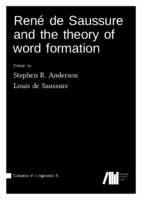René de Saussure and the theory of word formation
Contributor(s)
Anderson, Stephen R. (editor)
de Saussure, Louis (editor)
Collection
Knowledge Unlatched (KU)Number
103596Language
EnglishAbstract
This volume presents two works elaborating a general theory of words and their structure written by René de Saussure, younger brother of Ferdinand de Saussure. Although originating in René de Saussure's concerns for the structure of Esperanto, these essays are clearly intended to articulate a general account of word formation in natural language. They appear here in the French original with facing English translations, accompanied by some remarks on René de Saussure's life and followed by essays on the Esperantist background of his analysis (by Marc van Oostendorp), the contemporary relevance of his morphological theory (by Stephen Anderson), and the semantic theory of words underlying his analysis (by Louis de Saussure). These two works have remained essentially unknown to the community of scholars in general linguistics since their publication in 1911 and 1919, respectively, although Esperantists have been aware of them. They develop in quite explicit form a theory of what would later be called morphemic analysis, based primarily on data from French (with some material from German and English, as well as occasional examples from other Indo-European languages). In its fundamental aspect, René's view of word formation differed significantly from that of his brother, who saw the structure of complex words as revealed not through their decomposition into smaller "atomic" units but rather in the relations between words, relations which could be presented in analogical form and which anticipate rule-based theories of morphological structure. The contrast between the two brothers' views thus anticipates basic issues in current theorizing about word structure.


 Download
Download